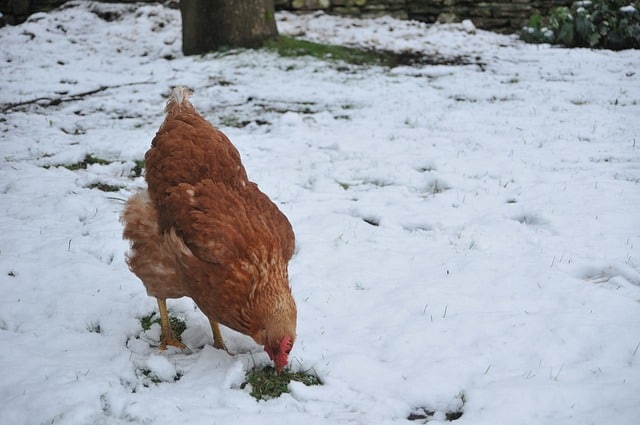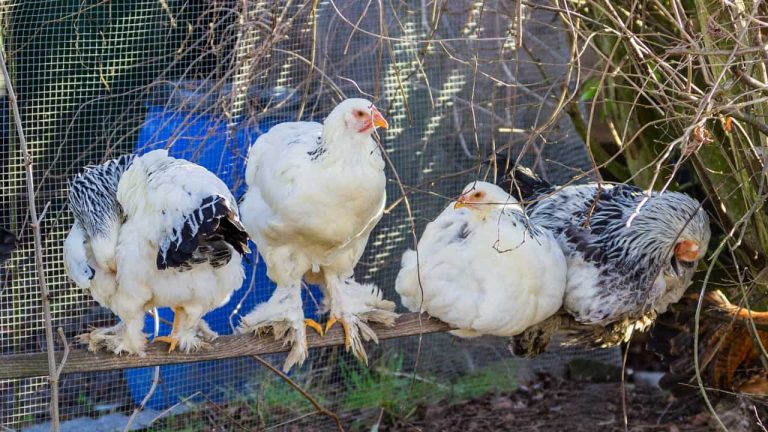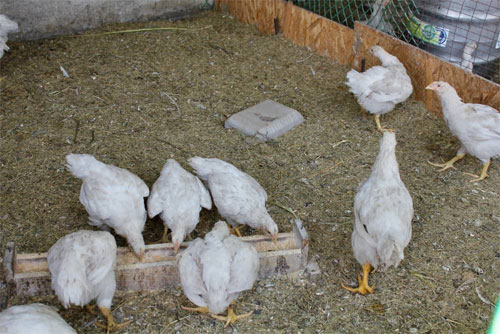The health and productivity of chickens depend on their living conditions. These two factors are also directly proportional to your return on investment, whether you are keeping the birds for eggs, meat, or as pets.
Housing is one of the most important factors you must consider before venturing into backyard chicken farming. When setting up a chicken coop, there are several essentials you need to ensure the comfort, safety, and well-being of your chickens.
Here are some important items you should install in your chicken coop:
Contents
1. Roosting Bars
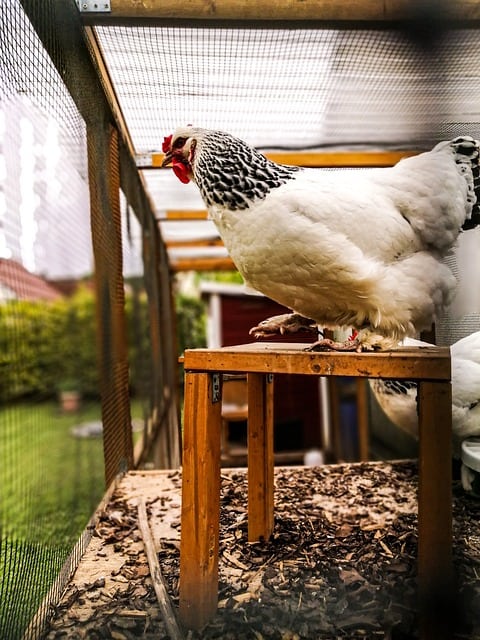
Chickens need a place to perch and sleep at night. Install sturdy roosting bars or branches at an appropriate height inside the coop, allowing each chicken to have enough space.
Chickens prefer to roost at higher elevations to feel safe from ground-level predators. The recommended height is around 12–18 inches (30–45 cm) above the floor. Also, provide enough length on the roosting bars to accommodate all your chickens comfortably. Each chicken should ideally have 8–10 inches (20–25 cm) of roosting space.
Select a suitable diameter for the roosting bars. A rounded surface with a diameter of 1.5–2 inches (4-5 cm) works well for most chicken breeds. This allows chickens to wrap their feet around the bar without causing discomfort.
Create enough spacing between the roosting bars to prevent overcrowding. Leave at least 12 inches (30 cm) of space between each bar to allow chickens to move and hop on and off easily. You can also install the roosting bars parallel to each other, leaving enough headroom for chickens to perch comfortably without touching the ceiling of the coop.
Finally, you must regularly clean and inspect the roosting bars for droppings or parasites. You can cover the bars with a removable tray or newspaper to make cleaning easier.
2. Nesting Boxes
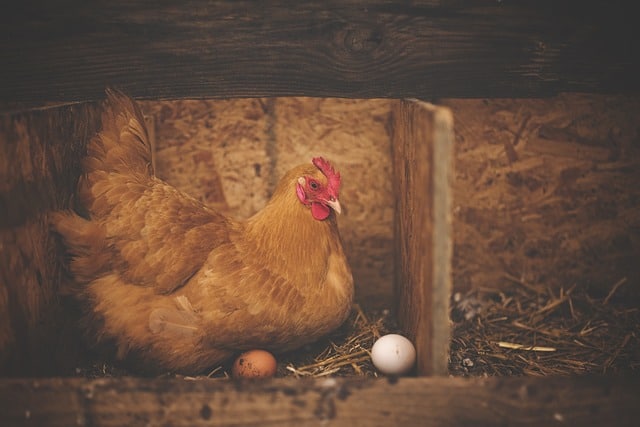
Nesting boxes for chickens are designed to provide a comfortable and secure space for hens to lay their eggs. These boxes are typically placed within a chicken coop or a dedicated nesting area to encourage hens to lay eggs in a designated spot.
Here are some key points to consider when setting up nesting boxes for chickens:
- Size: The size of the nesting boxes should be appropriate for the breed and size of your chickens. A general guideline is to have nesting boxes that are around 12 inches (30 cm) wide, 12 inches (30 cm) deep, and 12 inches (30 cm) high. However, larger or smaller boxes may be suitable, depending on the size of your flock.
- Placement: Choose a quiet and dark area within the coop or nesting area to place the nesting boxes. Hens prefer privacy when laying eggs, so a secluded location can help create a comfortable environment for them.
- Number of Boxes: Provide enough nesting boxes to accommodate your flock. A general rule of thumb is to have one nesting box for every 4–5 hens. This prevents overcrowding and minimizes the chances of hens laying eggs on the coop floor.
- Bedding: Line the nesting boxes with suitable bedding material to create a soft and cozy nest for the hens. Popular choices for bedding include straw, hay, wood shavings, or nesting pads specifically designed for this purpose.
- Accessibility: Ensure that the nesting boxes are easily accessible for the hens. The entrance to the boxes should be low enough for the hens to enter comfortably. You can also add a small step or ladder to help them access the boxes if they are elevated.
- Cleaning and Maintenance: Regularly clean and replace the bedding in the nesting boxes to maintain cleanliness and prevent the spread of bacteria. Collect eggs frequently to avoid breakage or accidental pecking by other hens.
3. Ventilation
Ventilation is an essential aspect of providing a healthy environment for chickens in their coop or housing. Proper ventilation helps regulate air quality, temperature, and humidity levels, which are crucial for the well-being and productivity of the birds.
Here are some key points to consider when it comes to ventilation in a chicken coop:
- Air Circulation: Good air circulation helps prevent the buildup of stagnant air, moisture, and odors inside the coop. It allows for the exchange of fresh air and removes potentially harmful gasses, such as ammonia, which can be emitted from droppings. Adequate air movement helps maintain a more comfortable and healthier environment for the chickens.
- Vent Openings: Provide well-placed vent openings in the coop to allow fresh air to enter and stale air to exit. The size and number of vents depend on the size of the coop and the number of birds. Vents can be placed near the top of the coop to let warm, moist air escape, while vents near the bottom can allow fresh air to enter.
- Protection from Drafts: While ventilation is important, it’s equally crucial to protect the birds from direct drafts, especially during cold weather. Direct drafts can cause stress and respiratory issues in chickens. To achieve a balance, ensure that vents are positioned higher up or have baffles that direct airflow upwards, away from the birds.
- Mesh Screens: Install mesh screens over vents and openings to prevent pests, predators, and wild birds from entering the coop. Mesh screens also help filter out dust and debris from entering the coop while still allowing proper airflow.
- Natural Ventilation: Whenever possible, take advantage of natural ventilation by incorporating windows, openings, or vents that can be adjusted based on weather conditions. This allows for the natural intake of fresh air and the expulsion of warm, moist air.
- Seasonal Considerations: Adjust the ventilation in the coop according to the seasons. During hotter months, provide ample ventilation to help cool down the coop and reduce heat stress. In colder months, ensure that ventilation is still present, but take measures to prevent drafts and keep the birds protected from extreme cold temperatures.
4. Lighting
Lighting is an important aspect to consider when it comes to raising chickens, as it can have a significant impact on their health, behavior, and productivity. Consider the following regarding lighting in a chicken coop or housing:
- Natural Light: Whenever possible, provide access to natural daylight for the chickens. Natural light helps regulate their circadian rhythm, promotes better overall health, and supports natural behaviors. Windows or transparent panels in the coop can allow sunlight to enter during the day. However, ensure that direct sunlight does not cause excessive heat or create uncomfortable conditions for the birds.
- Artificial Lighting: In situations where natural light is limited or insufficient, supplemental artificial lighting can be used to provide adequate illumination. Artificial lighting is particularly important during shorter daylight periods, such as in winter or in areas with less sunlight. Lighting can be used to extend the daily light exposure, ensuring the birds receive a minimum of 14–16 hours of light per day.
- Light Intensity: Chickens require appropriate light intensity for various activities, such as feeding, drinking, and moving around. Ensure that the lighting is bright enough to allow them to see clearly without causing excessive glare or discomfort. A recommended light intensity for general illumination in the coop is around 10–20 lux (approximately 1-2 foot-candles).
- Light Spectrum: The spectrum of light can also impact chicken behavior and productivity. Natural daylight contains the full spectrum of light, including blue and red wavelengths. LED or fluorescent lights with a balanced spectrum, including both cool and warm tones, can mimic natural light and provide optimal conditions for the chickens.
- Photoperiod Manipulation: Lighting can be used strategically to manipulate the photoperiod (duration of light exposure) to influence chicken behavior and reproductive cycles. For example, in commercial egg production, hens may be subjected to extended periods of light to stimulate egg-laying. Consulting guidelines or seeking advice specific to the breed and purpose of your chickens is important when considering photoperiod manipulation.
- Lighting Management: Consistency and regularity in lighting schedules are crucial for the well-being of chickens. Maintain a consistent lighting schedule, ensuring the lights turn on and off at the same times each day. Abrupt changes in lighting can cause stress or disrupt their natural behaviors.
Always ensure that lighting fixtures and electrical systems in the chicken coop are installed properly and safely, adhering to electrical codes and regulations. Regularly inspect lighting equipment, replace any faulty bulbs, and keep the area free from dust or debris that may reduce lighting effectiveness.
Proper lighting management supports the overall health, behavior, and productivity of chickens. It’s important to consider their natural needs, seek guidance specific to your flock, and provide appropriate lighting conditions to create a comfortable and conducive environment for the birds.
5. Feeders and Waterers
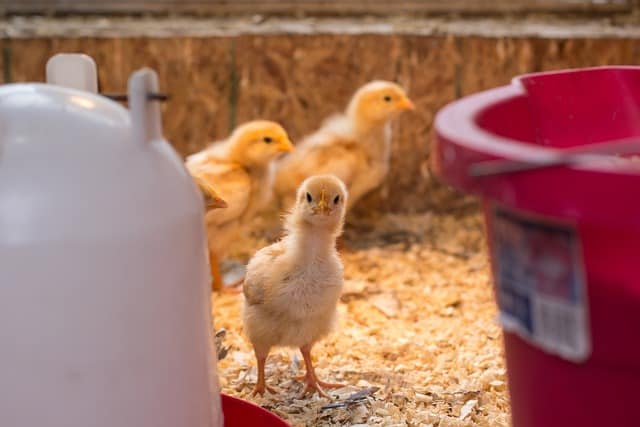
Feeders and waterers are essential equipment for providing food and water to chickens in a convenient and efficient manner. Here are some key points to consider when it comes to feeders and waterers for your flock:
Feeders:
- Type of Feeder: There are various types of feeders available, including trough feeders, tube feeders, and hanging feeders. Choose a feeder type that suits your flock size, coop setup, and the type of feed you provide.
- Size and capacity: The feeder should be large enough to accommodate the number of chickens you have. It should have sufficient capacity to hold an appropriate amount of feed, reducing the frequency of refilling. Consider factors like the average daily feed consumption of your flock to determine the size and capacity of the feeder.
- Pest and Rodent Control: Select a feeder that helps prevent pests and rodents from accessing the feed. Some feeders come with lids or covers that deter pests, ensuring the feed remains clean and free from contamination.
- Easy Access: The feeder should allow easy access to the feed for chickens while minimizing waste. Look for designs that prevent chickens from scratching or scattering the feed out of the feeder. Adjustable or removable baffles or covers can be useful in controlling feed access and reducing waste.
- Durability and Cleanability: Choose a feeder made of sturdy and durable materials that can withstand pecking, scratching, and general wear and tear. Additionally, ensure that the feeder is easy to clean and maintain to promote good hygiene and prevent the buildup of mold or bacteria.
Waterers:
- Type of Waterer: Waterers come in various types, such as gravity-fed waterers, nipple waterers, or automatic waterers. Each type has its advantages, so consider factors like ease of use, cleanliness, and suitability for your flock size when choosing a waterer.
- Size and Capacity: Similar to feeders, the waterer should be appropriately sized to accommodate the number of chickens and provide sufficient water. Consider the water consumption rate of your flock when selecting a waterer with an adequate capacity.
- Clean Water Supply: Ensure a clean and fresh water supply by regularly cleaning and refilling the waterer. Automatic waterers with built-in filtration systems can help maintain water cleanliness for longer periods of time.
- Freeze Protection (in colder climates): If you live in a region with freezing temperatures, consider using heated waterers or implementing measures to prevent water from freezing, such as using heated bases or insulated covers.
- Accessibility and Placement: Position the waterer at a comfortable height for the chickens, allowing easy access without spilling or contaminating the water. Place the waterer in a shaded area to prevent overheating and algae growth in warm weather.
Regularly monitor feeders and waterers to ensure they are functioning properly, clean, and free from debris. Refill feeders and waterers as needed to provide a continuous supply of food and water for your chickens. Properly maintained and appropriate feeders and waterers contribute to the overall health, well-being, and productivity of your flock.
6. Bedding

When it comes to bedding for chickens, there are several options you can consider. The primary purpose of bedding is to provide a comfortable and clean surface for your chickens to walk, roost, and nest on. It also helps absorb moisture and odors while maintaining good hygiene in the coop. Here are some common choices for chicken bedding:
- Straw: Straw is a popular bedding choice for chickens. It’s relatively inexpensive, readily available, and provides good insulation. However, straw can become compacted over time and may require frequent replacement.
- Wood Shavings: Wood shavings, such as pine or cedar shavings, are another common option. They absorb moisture well and have a pleasant scent. Avoid using cedar shavings in excessive quantities, as the aromatic oils can potentially irritate chickens’ respiratory systems.
- Hay: While hay can be used as bedding, it tends to be less absorbent compared to straw or wood shavings. Hay is better suited for nesting boxes than the entire coop floor.
- Sand: Some chicken keepers prefer using sand as bedding because it drains well and is easy to clean. Sand also discourages pests like mites and lice. However, chickens can kick sand around, making it messier than other options.
- Hemp Bedding: Hemp bedding is an eco-friendly option that provides good moisture absorption. It’s low-dust, antimicrobial, and has a longer lifespan compared to straw or wood shavings. However, it can be more expensive.
7. Litter Tray
Using a litter tray or droppings board in the chicken coop can make cleaning and waste management easier. Here’s how you can set up a litter tray for chickens:
- Select a suitable tray: Choose a tray that is large enough to accommodate the droppings of your chickens. It should be easy to clean and made of durable material that can withstand the moisture and scratching of the chickens.
- Position the tray: Place the tray underneath the roosting bars or perches where the chickens spend most of their time. This will allow the droppings to fall directly into the tray, minimizing the mess in the rest of the coop.
- Bed the tray: Add an appropriate bedding material to the tray. Wood shavings or straw work well for this purpose. The bedding will help absorb moisture and odors while providing a comfortable surface for the chickens.
- Provide access: Ensure that the chickens can easily access the roosting bars and the litter tray. If necessary, add ramps or steps to help them reach the desired areas.
- Regular cleaning: Check the litter tray daily and remove any soiled bedding or droppings. Replace the bedding as needed to maintain cleanliness and prevent odors.
- Utilize the waste: Chicken droppings are a valuable source of nutrients, so you can use the collected droppings from the litter tray as fertilizer for your garden or compost pile. Make sure to age or compost the droppings properly before using them on plants.
8. Predator Protection

Protecting your chickens from predators is crucial to ensuring their safety. Here are some important measures you can take to enhance predator protection:
- Secure Coop Design: Build or purchase a sturdy and predator-resistant chicken coop. Use strong materials such as hardware cloth or welded wire mesh with small openings to prevent predators from entering. Ensure that there are no gaps or openings that predators can squeeze through. Reinforce doors, windows, and vents with secure latches.
- Fencing: Install a secure fencing system around the coop and the outdoor area where your chickens have access. Use buried hardware cloth or wire mesh extending at least a foot underground to deter predators from digging underneath the fence. The fence height should be tall enough to prevent predators from jumping over it.
- Electric Fencing: Electric fencing can be an effective deterrent for predators. Install an electric fence around the perimeter of your chicken enclosure, making sure the wires are properly energized. This can discourage predators from attempting to breach the fence.
- Predator-Proof Run: Create a predator-proof run or outdoor enclosure for your chickens. Use hardware cloth or wire mesh to cover the top of the run to prevent aerial predators like hawks or owls from swooping in. Ensure that the sides of the run are secure and cannot be easily accessed by digging or climbing predators.
- Nighttime Protection: Most predator attacks occur during the night. Close and secure the coop door at dusk to keep predators out. Consider using an automated door that opens and closes on a timer to ensure your chickens are safely locked up at night.
- Predator Deterrents: Install predator deterrents around your chicken coop and run. Motion-activated lights, noise-making devices, and even guard animals like dogs or geese can help deter predators.
- Remove Attractants: Keep the area around the coop clean and free of food scraps or spilled feed that may attract predators. Securely store feed and other potential food sources in predator-resistant containers.
- Vigilance and observation: regularly inspect the coop and the surrounding area for signs of predator activity. Look for tracks, holes, or signs of digging that may indicate the presence of predators. Address any vulnerabilities promptly.
- Educate yourself: Learn about the predators in your area and their behaviors. This knowledge can help you understand potential threats and implement appropriate measures for predator protection.
- Perimeter Lighting: Consider installing perimeter lighting around the coop to deter nocturnal predators and enhance security during the night.
Also read: Chicken Coop: The Ultimate Guide On How To Choose The Right Size
Conclusion
You have to think of all these essentials before you bring in the birds if you want to succeed in your chicken-keeping venture. You may learn of other things along the way, but these are the bare minimums. Remember to regularly clean and maintain your chicken coop to keep it hygienic and comfortable for your feathered friends. Additionally, check local regulations and guidelines for any specific requirements in your area.




